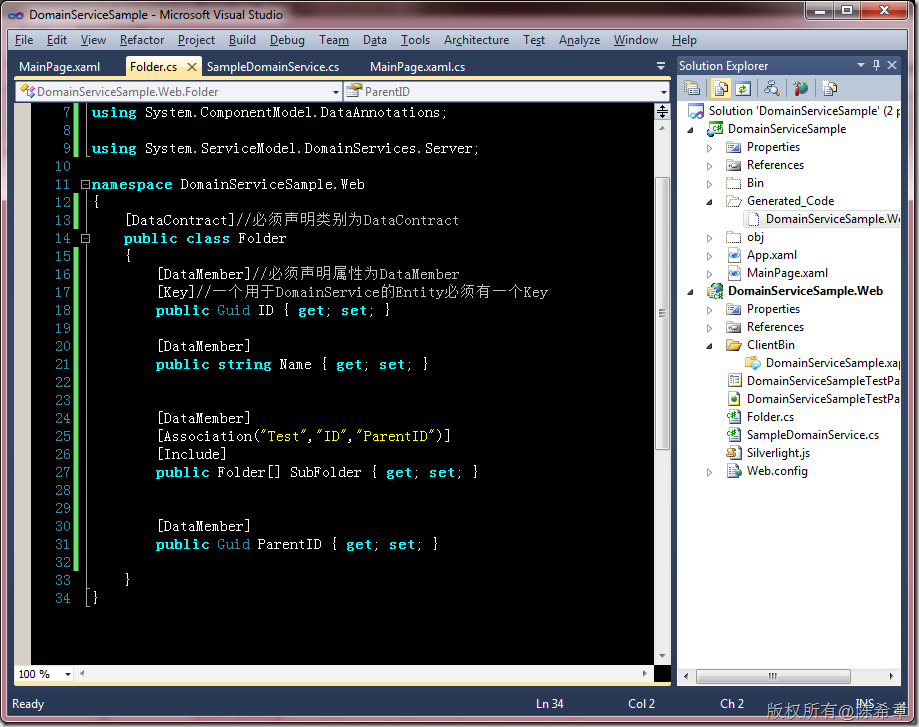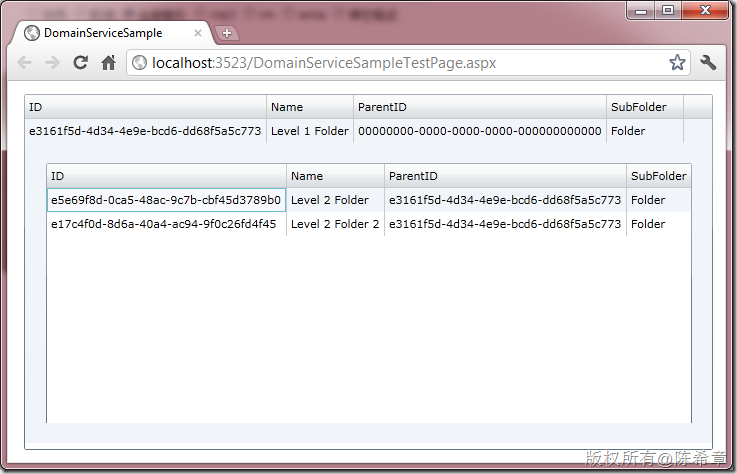RIA Service中对于递归实体类型处理的问题及解决方案
故事是这样开始的:
我们在开发一个Silverlight应用程序的时候使用到了RIA Service,我们需要通过该服务公开一个对文件夹的查询操作。
为此,我们建立了如下的一个实体类型
using System; using System.Collections.Generic; using System.Linq; using System.Web; using System.Runtime.Serialization; using System.ComponentModel.DataAnnotations; using System.ServiceModel.DomainServices.Server; namespace DomainServiceSample.Web { [DataContract]//必须声明类别为DataContract public class Folder { [DataMember]//必须声明属性为DataMember [Key]//一个用于DomainService的Entity必须有一个Key public Guid ID { get; set; } [DataMember] public string Name { get; set; } [DataMember]
public Folder[] SubFolder { get; set; }
}
}
【注意】上面其实是有一个递归的类型,也就是Folder里面又包含Folder
然后,我们创建了一个DomainService
namespace DomainServiceSample.Web { using System; using System.Collections.Generic; using System.ComponentModel; using System.ComponentModel.DataAnnotations; using System.Linq; using System.ServiceModel.DomainServices.Hosting; using System.ServiceModel.DomainServices.Server; // TODO: Create methods containing your application logic. [EnableClientAccess()] public class SampleDomainService : DomainService { [Query] public IQueryable<Folder> GetFolder() { var folder = new Folder() { ID = Guid.NewGuid(), Name = "Level 1 Folder" }; var subFolders = new[]{ new Folder(){ID=Guid.NewGuid(),Name="Level 2 Folder"}, new Folder(){ID=Guid.NewGuid(),Name="Level 2 Folder 2"} }; folder.SubFolder = subFolders; return new[] { folder }.AsQueryable(); } } }
这个代码没有什么特别的,我们计划向客户端发送的结果是一个Folder,但同时它包含了两个子Folder。
编写上面两个类型很顺利,然后我们生成项目,因为使用了Domain Service,所以在Silverlight应用程序中会得到一个自动生成的类型
我们打开那个文件,确实里面是有一个Folder的类型
/// <summary> /// The 'Folder' entity class. /// </summary> [DataContract(Namespace="http://schemas.datacontract.org/2004/07/DomainServiceSample.Web")] public sealed partial class Folder : Entity { private Guid _id; private string _name; #region Extensibility Method Definitions /// <summary> /// This method is invoked from the constructor once initialization is complete and /// can be used for further object setup. /// </summary> partial void OnCreated(); partial void OnIDChanging(Guid value); partial void OnIDChanged(); partial void OnNameChanging(string value); partial void OnNameChanged(); #endregion /// <summary> /// Initializes a new instance of the <see cref="Folder"/> class. /// </summary> public Folder() { this.OnCreated(); } /// <summary> /// Gets or sets the 'ID' value. /// </summary> [DataMember()] [Editable(false, AllowInitialValue=true)] [Key()] [RoundtripOriginal()] public Guid ID { get { return this._id; } set { if ((this._id != value)) { this.OnIDChanging(value); this.ValidateProperty("ID", value); this._id = value; this.RaisePropertyChanged("ID"); this.OnIDChanged(); } } } /// <summary> /// Gets or sets the 'Name' value. /// </summary> [DataMember()] public string Name { get { return this._name; } set { if ((this._name != value)) { this.OnNameChanging(value); this.RaiseDataMemberChanging("Name"); this.ValidateProperty("Name", value); this._name = value; this.RaiseDataMemberChanged("Name"); this.OnNameChanged(); } } } /// <summary> /// Computes a value from the key fields that uniquely identifies this entity instance. /// </summary> /// <returns>An object instance that uniquely identifies this entity instance.</returns> public override object GetIdentity() { return this._id; } }
但是,让人疑惑的是,这个类型里面并没有包含SubFolder这个属性
这是什么情况呢?难道RIA Service不允许传递这种包含递归类型引用的实体?确实如此。
我目前的解决方法是:
1. 为Folder类型添加一个ParentID属性
2. 为SubFolder设置关联,即子Folder的ParentID设置到父Folder的ID。并且定义他们的关联
3. 使用Include属性标记SubFolder是要包含进来的
所以,这个类型修改为下面这样
using System; using System.Collections.Generic; using System.Linq; using System.Web; using System.Runtime.Serialization; using System.ComponentModel.DataAnnotations; using System.ServiceModel.DomainServices.Server; namespace DomainServiceSample.Web { [DataContract]//必须声明类别为DataContract public class Folder { [DataMember]//必须声明属性为DataMember [Key]//一个用于DomainService的Entity必须有一个Key public Guid ID { get; set; } [DataMember] public string Name { get; set; } [DataMember] [Association("Test","ID","ParentID")] [Include] public Folder[] SubFolder { get; set; } [DataMember] public Guid ParentID { get; set; } } }
然后,我们再来看在Silverlight中生成的那个类型
/// <summary> /// The 'Folder' entity class. /// </summary> [DataContract(Namespace="http://schemas.datacontract.org/2004/07/DomainServiceSample.Web")] public sealed partial class Folder : Entity { private Guid _id; private string _name; private Guid _parentID; private EntityCollection<Folder> _subFolder; #region Extensibility Method Definitions /// <summary> /// This method is invoked from the constructor once initialization is complete and /// can be used for further object setup. /// </summary> partial void OnCreated(); partial void OnIDChanging(Guid value); partial void OnIDChanged(); partial void OnNameChanging(string value); partial void OnNameChanged(); partial void OnParentIDChanging(Guid value); partial void OnParentIDChanged(); #endregion /// <summary> /// Initializes a new instance of the <see cref="Folder"/> class. /// </summary> public Folder() { this.OnCreated(); } /// <summary> /// Gets or sets the 'ID' value. /// </summary> [DataMember()] [Editable(false, AllowInitialValue=true)] [Key()] [RoundtripOriginal()] public Guid ID { get { return this._id; } set { if ((this._id != value)) { this.OnIDChanging(value); this.ValidateProperty("ID", value); this._id = value; this.RaisePropertyChanged("ID"); this.OnIDChanged(); } } } /// <summary> /// Gets or sets the 'Name' value. /// </summary> [DataMember()] public string Name { get { return this._name; } set { if ((this._name != value)) { this.OnNameChanging(value); this.RaiseDataMemberChanging("Name"); this.ValidateProperty("Name", value); this._name = value; this.RaiseDataMemberChanged("Name"); this.OnNameChanged(); } } } /// <summary> /// Gets or sets the 'ParentID' value. /// </summary> [DataMember()] public Guid ParentID { get { return this._parentID; } set { if ((this._parentID != value)) { this.OnParentIDChanging(value); this.RaiseDataMemberChanging("ParentID"); this.ValidateProperty("ParentID", value); this._parentID = value; this.RaiseDataMemberChanged("ParentID"); this.OnParentIDChanged(); } } } /// <summary> /// Gets the collection of associated <see cref="Folder"/> entity instances. /// </summary> [Association("Test", "ID", "ParentID")] public EntityCollection<Folder> SubFolder { get { if ((this._subFolder == null)) { this._subFolder = new EntityCollection<Folder>(this, "SubFolder", this.FilterSubFolder); } return this._subFolder; } } private bool FilterSubFolder(Folder entity) { return (entity.ParentID == this.ID); } /// <summary> /// Computes a value from the key fields that uniquely identifies this entity instance. /// </summary> /// <returns>An object instance that uniquely identifies this entity instance.</returns> public override object GetIdentity() { return this._id; } }
这时就看到SubFolder了,而且还包含了很多其他的属性。
最后,我做了一个界面来显示给大家看看效果
MainPage.xaml的内容如下
<UserControl x:Class="DomainServiceSample.MainPage" xmlns="http://schemas.microsoft.com/winfx/2006/xaml/presentation" xmlns:x="http://schemas.microsoft.com/winfx/2006/xaml" xmlns:d="http://schemas.microsoft.com/expression/blend/2008" xmlns:mc="http://schemas.openxmlformats.org/markup-compatibility/2006" mc:Ignorable="d" d:DesignHeight="300" d:DesignWidth="400" xmlns:sdk="http://schemas.microsoft.com/winfx/2006/xaml/presentation/sdk"> <Grid x:Name="LayoutRoot" Background="White"> <sdk:DataGrid AutoGenerateColumns="True" Margin="16,13,12,12" Name="dataGrid1" ItemsSource="{Binding}" RowDetailsVisibilityMode="Visible"> <sdk:DataGrid.RowDetailsTemplate> <DataTemplate> <sdk:DataGrid AutoGenerateColumns="True" Margin="20,20,20,20" Height="300" ItemsSource="{Binding SubFolder}" /> </DataTemplate> </sdk:DataGrid.RowDetailsTemplate> </sdk:DataGrid> </Grid> </UserControl>
MainPage.xaml.cs的内容如下
using System; using System.Collections.Generic; using System.Linq; using System.Net; using System.Windows; using System.Windows.Controls; using System.Windows.Documents; using System.Windows.Input; using System.Windows.Media; using System.Windows.Media.Animation; using System.Windows.Shapes; using DomainServiceSample.Web; namespace DomainServiceSample { public partial class MainPage : UserControl { public MainPage() { InitializeComponent(); Loaded += new RoutedEventHandler(MainPage_Loaded); } void MainPage_Loaded(object sender, RoutedEventArgs e) { var ctx = new SampleDomainContext(); var op = ctx.Load<Folder>(ctx.GetFolderQuery()); dataGrid1.DataContext = op.Entities; } } }
同时,服务端的代码我也稍作了修改
namespace DomainServiceSample.Web { using System; using System.Collections.Generic; using System.ComponentModel; using System.ComponentModel.DataAnnotations; using System.Linq; using System.ServiceModel.DomainServices.Hosting; using System.ServiceModel.DomainServices.Server; // TODO: Create methods containing your application logic. [EnableClientAccess()] public class SampleDomainService : DomainService { [Query] public IQueryable<Folder> GetFolder() { var folder = new Folder() { ID = Guid.NewGuid(), Name = "Level 1 Folder" }; var subFolders = new[]{ new Folder(){ID=Guid.NewGuid(),Name="Level 2 Folder",ParentID=folder.ID}, new Folder(){ID=Guid.NewGuid(),Name="Level 2 Folder 2",ParentID=folder.ID} }; folder.SubFolder = subFolders; return new[] { folder }.AsQueryable(); } } }
调试起来看到的效果如下
虽然解决了问题,但个人感觉Domain Service这个设计值得商榷。如果各位有更好的见解和解决方案,请不吝赐教





